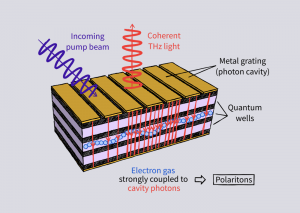Summary
An efficient source of terahertz radiation has the potential to improve characterization methods for drugs, proteins and bacteria, enable ultra-fast wireless data transfer over short distances for use in “smart factories”, and offer enhanced detection capabilities with the ability to see through packaging. However, terahertz light is particularly difficult to produce, and existing sources remain too bulky and power-hungry for widespread application.
We are working to develop more compact and efficient terahertz light sources using polaritons – hybrid particles consisting of a photon coupled strongly with a material excitation. This approach utilizes a plethora of quantum phenomena, from trapped photons, to quasiparticles, to Bose-Einstein condensation. By exploiting these unconventional effects we hope to pave the way towards a long-awaited practical source of terahertz light.

Related Content

Cryo-CMOS to Control and Operate 2D Fault-Tolerant Qubit Network
Summary Large-scale, fault-tolerant quantum computation requires precise and stable control of individual qubits. This project will use complementary metal-oxide-semiconductor (CMOS) technology to provide a cost-effective scalable platform for reliable and high-density control infrastructure for silicon spin qubits. We will use sub-micron CMOS technology to address device and circuit-level challenges and explore the integration of […]
June 14, 2018

Functionalized Nanodiamonds for Sensing Biochemical Processes
Summary Chemotherapy is limited by the failure to clinically monitor the efficacy of the treatment in real-time, which results in suboptimal chemotherapy being given for a prolonged period. Predicting the outcome of chemotherapy immediately after drug administration can increase diagnostic accuracy, efficacy outcomes, and successful treatment. Quantum nanodiamond sensors can be used as optical sensors […]
August 31, 2022

Quantum Sensing with Small Quantum Systems
Summary There are small quantum systems over which we have very good control and which have long lifetimes. Examples include the phosphorous (P) defect in silicon (Si) and the nitrogen vacancy (NV) defect in diamond. With P defect in Si, we focus on improving our understanding of the hyperpolarization mechanism to better enable engineering of […]
December 1, 2016

Quantum Light Sources Based on Deterministic Photon Subtraction
Summary This project develops new sources of light that utilize quantum entanglement to enhance imaging resolution and detection. We aim to go beyond simple photon pairs and advance our understanding and control of new quantum states of light. Our approach uses deterministic single-photon subtraction (removing of a specific photon from a pulse of light) […]
July 13, 2018

